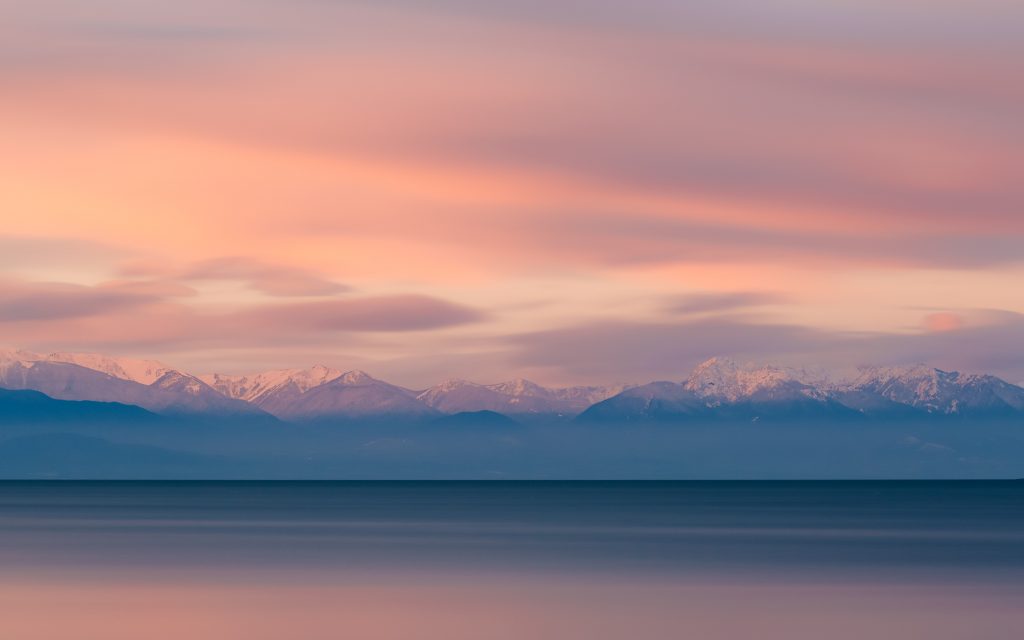by Iris Graville, from the Spring/Summer issue which is available now.
Nearly every issue of this journal includes interviews with wayfarers, described as those whose inner compass is ever-oriented to truth, wisdom, healing, and beauty in their own wandering. These stories of present-day writers, artists, activists, and spiritual leaders guide us in our own travels.
But what if we could time-travel to pose the burning questions of our times to wayfarers from the past? Kathleen Dean Moore did just that in her “posthumous interview” of Edward Abbey in Great Tide Rising: Towards Clarity and Moral Courage in a Time of Planetary Change (Counterpoint, 2016). Someone I’d want to converse with is Rachel Carson, an early writer about threats to the environment and author of Silent Spring (Houghton Mifflin, 1962).
One of Carson’s early books, The Sea Around Us (Oxford University Press, 1951), serves as a biography of the sea, noted for both its science and its poetic prose. I found great inspiration from it for my essay collection, Writer in a Life Vest: Essays from the Salish Sea (2022, Homebound Publications). The Salish Sea desperately needs Carson right now, so I borrowed Moore’s technique to devise my own questions to fit Carson’s previously-published words for replies. I imagine our conversation going something like this.

IRIS GRAVILLE: You’re a well-respected thinker and writer about conservation, and you spent a lot of time studying the sea. What drew you to the ocean?
RACHEL CARSON: As long as I can remember, it [the sea] has fascinated me. Even as a child—long before I had ever seen it—I used to imagine what it would look like, and what the surf sounded like. Since I grew up in an inland community, where we hadn’t even a migrating seagull, I had to wait a long time to have my curiosity satisfied. As a matter of fact, it wasn’t until I had graduated from college and gone to Woods Hole [Marine Biological Laboratory] … that I saw the ocean. There, I began to get my first real understanding of the real sea world, that is, the world as it is known by shore-birds and fishes and beach crabs and all the other creatures that live in the sea or along its edge.1 Fish, amphibian, and reptile, warm-blooded bird and mammal—each of us carries in our veins a salty stream in which the elements sodium, potassium, and calcium are combined in almost the same proportions as in seawater.2
IG: I live on the Salish Sea in Washington State. I feel both fortunate to live so close to the sea and distressed by the visible effects of climate change around me. But so many people don’t live anywhere near an ocean. Why should they care?
RC: Even in the vast and mysterious reaches of the sea, we are brought back to the fundamental truth that nothing lives to itself. 3 Water must be thought of in terms of the chains of life it supports.4
IG: At the centennial of your birth, the United States House of Representatives passed a resolution in your honor. Here’s one portion of the resolution:
Resolved, That the House of Representatives—
recognizes that we could learn much from her today,
especially as we increasingly feel the effects
of climate change and consider measures to lessen
and eventually, reverse the impact it has on our planet.
What do you think is the most important learning we could gain from you today?
RC: We cannot think of the living organism alone; nor can we think of the physical environment as a separate entity. The two exist together, each acting on the other to form an ecological complex or an ecosystem. With these surface waters, through a series of delicately adjusted, interlocking relationships, the life of all parts of the sea is linked. What happens to a diatom in the upper, sunlit strata of the sea may well determine what happens to a cod lying on a ledge of some rocky canyon a hundred fathoms below, or to a bed of multicolored, gorgeously plumed sea worms carpeting an underlying shoal, or to a prawn creeping over the soft oozes of the sea floor in the blackness of mile-deep water.5
IG: It seems the more we learn, the more complicated the natural world is, and the more unattainable renewal is. How did we get here, and how can we change?
RC: We behave, not like people guided by scientific knowledge, but more like the proverbial bad housekeeper who sweeps the dirt under the rug in the hope of getting it out of sight. We dump wastes of all kinds into our streams, with the object of having them carried away from our shores. We discharge the smoke and fumes of a million smokestacks and burning rubbish heaps into the atmosphere in the hope that the ocean of air is somehow vast enough to contain them. Now, even the sea has become a dumping ground, not only for assorted rubbish, but for the poisonous garbage of the atomic age. And this is done, I repeat, without recognition of the fact that introducing harmful substances into the environment is not a one-step process. It is changing the nature of the complex ecological system and is changing it in ways that we usually do not foresee until it is too late. This lack of foresight is one of the most serious complications, I think. It is not half so important to know as to feel. The more clearly we can focus our attention on the wonders and realities of the universe about us, the less taste we shall have for destruction.6
IG: It can be difficult for people to believe that climate change is truly a crisis and that we humans are responsible for it. It’s as if we’re unwilling to look at the damage we continue to cause. How would you convince us to take this destruction seriously?
RC: In spite of the truly marvelous inventiveness of the human brain, we are beginning to wonder whether our power to change the face of nature should not have been tempered with wisdom for our own good, and with a greater sense of responsibility for the welfare of generations to come. Contrary to the beliefs that seem often to guide our actions, man does not live apart from the world; he lives in the midst of a complex, dynamic interplay of physical, chemical, and biological forces, and between himself and this environment there are continuing, never-ending interactions. One way to open your eyes is to ask yourself—What if I had never seen this before? What if I knew I would never see it again?7
IG: You received the National Book Award for The Sea Around Us, and it was described as poetic. Do you think of your writing as poetry?
RC: If there is poetry in my book about the sea, it is not because I deliberately put it there, but because no one could write truthfully about the sea and leave out the poetry.8
IG: I’m deeply grateful for your writings about the ocean and environmental protection. Composing essays and poems is my response to the climate crisis, but I often question if that’s of any use. What are your thoughts about the value of creative writing?
RC: The aim of science is to discover and illuminate truth. And that, I take it, is the aim of literature.9 A good deal of poetry and stories have been focused on the sea, and quite a bit of science as well. But the best writing combines the two. The books that influence—that push movements forward—are the books that marry science and emotion.10
IG: Every day, news reports about repealed environmental policies, extinction of animals, wildfires, oil spills, and rising seas frighten and wear me (and many others) down. How do we keep our spirits up?
RC: Those who contemplate the beauty of the earth find reserves of strength that will last as long as life lasts. There is something infinitely healing in the repeated refrains of nature—the assurance that dawn comes after night and spring after winter.11
IG: Thank you, Ms. Carson. Your inner compass continues to be a crucial guide.
Iris Graville is the author of four nonfiction books: Writer in a Life Vest, Hands at Work, BOUNTY, and a memoir, Hiking Naked. She lives on Lopez Island, WA where she publishes SHARK REEF Literary Magazine, writes essays and blogs, and teaches. Learn more at irisgraville.com.
1-2 Carson, Rachel. The Sea Around Us. Oxford: Oxford University Press, 1951.
3-4 Carson, Rachel. Silent Spring. New York: Houghton Mifflin, 1962.
5 Carson, Rachel. The Sea Around Us. Oxford: Oxford University Press, 1951.
6 Excerpt from acceptance speech for the John Burroughs Medal in 1952 for The Sea Around Us.
7 Carson, Rachel. The Sense of Wonder. New York: Harper Collins, 1956.
8 Carson, Rachel. The Sea Around Us. Oxford: Oxford University Press, 1951.
9 Lear, Linda, ed. Lost Woods: The Discovered Writing of Rachel Carson. Boston: Beacon Press, 1998.
10 Excerpt from acceptance speech for the National Book Award in 1952 for The Sea Around Us.
11 Carson, Rachel. Silent Spring. New York: Houghton Mifflin, 1962.


